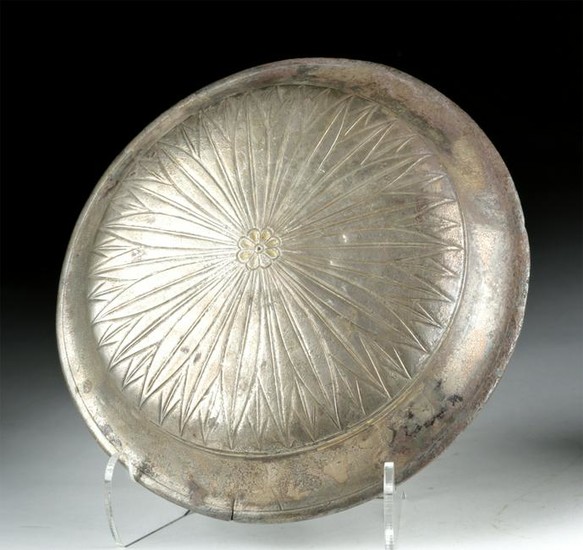Published / Exhibited Greek Silver Phiale
**Holiday Shipping Deadlines**
USA Domestic: 12/14 for Standard; 12/23 for Express; International: 12/7 for Standard; 12/19 for Express
Greece, Classical to early Hellenistic Period, ca. 500 to 300 BCE. A finely decorated cast 96% silver phiale, a special libation bowl used for holding wine. The body is smooth, with a slightly flanged, corseted neck, a flared, unpronounced rim, and a shallow interior. A small divot at the exact center may have once had something inlaid - a small jewel or bit of gold. The underside of the bowl features a beautiful motif of an eight-petaled flower on a field of dozens of spiky leaves. The central part of the flower is gilded. Size: 7.2" W x 1.35" H (18.3 cm x 3.4 cm); silver is 96% pure; total weight is 282.7 grams
Libation bowls, known as phiale, were used across a wide geographical area - from Greece to Tibet, throughout the ancient Near East and Central Asia. These shallow bowls for holding wine in ritual and ceremonial settings were made from many materials - glass, ceramic, and many kinds of metal. Royal vessels were made of precious metals, like this one. They functioned both as tableware and as wealth, and could be stored in the royal treasury or given as gifts to people they were hoping to influence.
Exhibited in "Dressed to Kill in Love and War: Splendor in the Ancient World", February 1 - March 31, 2019, Academy Art Museum, Maryland, USA, published in the exhibition guide by Sarah E. Cox and Anke Van Wagenberg, Fig. 7.
Provenance: private East Coast, USA collection; Exhibited in "Dressed to Kill in Love and War: Splendor in the Ancient World", February 1 - March 31, 2019, Academy Art Museum, Maryland, USA, published in the exhibition guide by Sarah E. Cox and Anke Van Wagenberg, Fig. 7; ex-private French collection, 2005; ex-Peter Knoebel collection, New York, USA, acquired in the 1990s; ex-Frances Artuner collection, Belgium, acquired in the 1960s
All items legal to buy/sell under U.S. Statute covering cultural patrimony Code 2600, CHAPTER 14, and are guaranteed to be as described or your money back.
A Certificate of Authenticity will accompany all winning bids.
We ship worldwide to most countries and handle all shipping in-house for your convenience.
#146248
Condition Report: Small tear/fissure to metal on one side, with wear around the rim and on the body commensurate with age, including slight bending to form. Gilt on underside is worn in places but the majority is still present.
View it on
Sale price
Estimate
Time, Location
Auction House
**Holiday Shipping Deadlines**
USA Domestic: 12/14 for Standard; 12/23 for Express; International: 12/7 for Standard; 12/19 for Express
Greece, Classical to early Hellenistic Period, ca. 500 to 300 BCE. A finely decorated cast 96% silver phiale, a special libation bowl used for holding wine. The body is smooth, with a slightly flanged, corseted neck, a flared, unpronounced rim, and a shallow interior. A small divot at the exact center may have once had something inlaid - a small jewel or bit of gold. The underside of the bowl features a beautiful motif of an eight-petaled flower on a field of dozens of spiky leaves. The central part of the flower is gilded. Size: 7.2" W x 1.35" H (18.3 cm x 3.4 cm); silver is 96% pure; total weight is 282.7 grams
Libation bowls, known as phiale, were used across a wide geographical area - from Greece to Tibet, throughout the ancient Near East and Central Asia. These shallow bowls for holding wine in ritual and ceremonial settings were made from many materials - glass, ceramic, and many kinds of metal. Royal vessels were made of precious metals, like this one. They functioned both as tableware and as wealth, and could be stored in the royal treasury or given as gifts to people they were hoping to influence.
Exhibited in "Dressed to Kill in Love and War: Splendor in the Ancient World", February 1 - March 31, 2019, Academy Art Museum, Maryland, USA, published in the exhibition guide by Sarah E. Cox and Anke Van Wagenberg, Fig. 7.
Provenance: private East Coast, USA collection; Exhibited in "Dressed to Kill in Love and War: Splendor in the Ancient World", February 1 - March 31, 2019, Academy Art Museum, Maryland, USA, published in the exhibition guide by Sarah E. Cox and Anke Van Wagenberg, Fig. 7; ex-private French collection, 2005; ex-Peter Knoebel collection, New York, USA, acquired in the 1990s; ex-Frances Artuner collection, Belgium, acquired in the 1960s
All items legal to buy/sell under U.S. Statute covering cultural patrimony Code 2600, CHAPTER 14, and are guaranteed to be as described or your money back.
A Certificate of Authenticity will accompany all winning bids.
We ship worldwide to most countries and handle all shipping in-house for your convenience.
#146248
Condition Report: Small tear/fissure to metal on one side, with wear around the rim and on the body commensurate with age, including slight bending to form. Gilt on underside is worn in places but the majority is still present.



